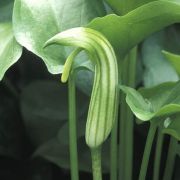|
|


| |||||||||||||||||||||||||||
|
The Genus Arisarum by Peter Boyce
Arisarum P. Miller, Gard. Dict. abr. ed., [121] (1754). Lectotype A. vulgare Targioni-Tozzetti (Arum arisarum L., see Nicolson in Taxon, 24: 467. 1975). Small, seasonally dormant herbs, stem an ovoid to cylindric tuber or slender rhizome (A. proboscideum) with stolons. Leaves 1 - 2( -3); petiole often sparsely spotted, sheath short; lamina cordate-sagittate to subhastate; primary lateral veins pinnate and also arising at petiole insertion, forming submarginal collective vein, 2 marginal veins also present, higher order venation reticulate. Inflorescence solitary, appearing with leaves; peduncle shorter or equalling leaf, often spotted; spathe eventually evanescent, tube erect, margins connate, cylindric to subventricose, slightly constricted at apex, white or with white to pale green longitudinal stripes, blade fornicate, gaping, sometimes subtomentose, apex cuspidate or drawn out into a very long, erect to twisted thread, greenish or brownish or purple-brown; spadix with female zone adnate to spathe, 2 - 5-flowered, contiguous with male zone, male zone laxly flowered, extending for more than half spathe tube length, appendix naked, either stipitate with massive apical knob, or stipitate with thick, clavate, basally truncate, fungoid, apical region, or not stipitate and slenderly clavate. Flowers unisexual, perigone absent. Staminate flowers 1-androus, filament terete, as long or longer than anther, anther peltately attached, circular, connective slender, thecae apically confluent, dehiscing by single continuous slit; pistillate flowers ovary 1-locular, depressed-globose, ovules many, orthotropous, funicle short, placenta basal, stylar region ± abruptly narrowed, stigma small, subhemispheric; berry hemispheric, flattened at apex with elevated angled margins, few-seeded, pericarp carnose-leathery, style base persistent; seed ovoid, with large, irregularly conoid strophiole (aril), testa longitudinally rugose, embryo terete, straight, axile, endosperm copious. 2n = 28, 42, 56. DISTRIBUTION. Mediterranean Europe, Macaronesia:– Alb Albania, Algeria, Bosnia-Hercegovina, Croatia, Cyprus, Egypt, France (incl. Corsica), Greece (incl. Crete), Israel, Italy (incl. Sardinia, Sicily), Lebanon, Libya, Macedonia, Malta, Morocco, Portugal (incl. Azores), Serbia, Slovenia, Spain (incl. Balearics, Canary Is.), Syria, Tunisia, Turkey. ECOLOGY. Warm temperate scrub and woodland; geophytes, on stony ground in macchie ("maquis"), between rocks or under trees and shrubs. ETYMOLOGY. Derived from the Greek word arisaron (as used by Dioscorides in reference to aris, aridos, the name of a small herb mentioned by Pliny, possibly Arisarum itself and aron (Arum)). KEY TO SPECIES
Arisarum vulgare Targ.Tozz., Anal. Mus. Imp. Fis. Firenze 2(2): 67 (1810). Balmisa vulgaris (Targ.Tozz.) Lag., Gen. Sp. Pl.: 17 (1816). Arum arisarum L., Sp. Pl.: 966 (1753). Arisarum arisarum (L.) Huth, Helios 11: 133 (1893), nom. inval. Arisarum latifolium Hill., Brit. Herb.: 336 (1756), nom. inval. Arum incurvatum Lam., Fl. Fran . 3:. 3: 538 (1779), nom. illeg. Arisarum incurvatum Holmboe, Stud. Veg. Cypr.: 43 (1914), nom. illeg. Arum arisarum Lour., Fl. Cochinch.: 655 (1790). Typhonium cochinchinense Blume, Rumphia 1: 135 (1837). Calyptrocoryne cochinchinensis (Blume) Schott, Prodr. Syst. Aroid.: 195 (1860). Arum calyptrale Salisb., Prodr. Stirp. Chap. Allerton: 261 (1796). Arisarum australe Rich., Arch. Bot. (Paris) 1: 20 (1833). Arisarum serpentrium Raf., Fl. Tellur. 3: 63 (1837). Arisarum azoricum Schott, Oesterr. Bot. Wochenbl. 7: 190 (1857). Arisarum balansae Schott, Oesterr. Bot. Wochenbl. 7: 190 (1857). Arisarum forbesii Schott, Oesterr. Bot. Wochenbl. 7: 190 (1857). Arisarum jacquinii Schott, Prodr. Syst. Aroid.: 22 (1860). Arisarum libani Schott, Prodr. Syst. Aroid.: 21 (1860). Arisarum sibthorpii Schott, Prodr. Syst. Aroid.: 21 (1860). Arisarum veslingii Schott, Prodr. Syst. Aroid.: 20 (1860). Arum libani Schott, Prodr. Syst. Aroid.: 21 (1860). Arisarum crassifolium Schott, Bonplandia 9: 369 (1861). Arisarum subalpinum Kotschy ex Engl. in A.L.P.de Candolle & A.C.P.de Candolle, Monogr. Phan. 2: 563 (1879). Arisarum latifolium Bubani, Fl. Pyren. 4: 29 (1901). DISTRIBUTION. Albania, Algeria, Bosnia-Hercegovina, Croatia, Cyprus, Egypt, France (incl. Corsica), Greece (incl. Crete), Israel, Italy (incl. Sardinia, Sicily), Lebanon, Libya, Macedonia, Malta, Morocco, Portugal (incl. Azores), Serbia, Slovenia, Spain (incl. Balearics, Canary Is.), Syria, Tunisia, Turkey. Arisarum simorrhinum var. subexertum (Webb & Berthel.) Talavera, Lagascalia 14: 115 (1986), no exact basionym date. Arisarum clusii Schott, Prodr. Syst. Aroid.: 23 (1860). Arisarum simorrhinum var. clusii (Schott) Talavera, Lagascalia 14: 116 (1986). Arisarum tingitanum Schott, Prodr. Syst. Aroid.: 22 (1860). Arisarum hastatum Pomel, Nouv. Mat. Fl. Atl.: 390 (1875). Arisarum vulgare subsp. exsertum Maire & Weiller, in Fl. Afr. Nord 4: 241 (1957). Arisarum vulgare subsp. transiens Maire & Weiller, in Fl. Afr. Nord 4: 241 (1957). DISTRIBUTION. Canary Islands, Portugal, Spain, Algeria, Morocco. 3. Arisarum aspergillum Dunal, Mém. Sect. Sci. Acad. Sci. Montpellier 1: 8 (1847). A. simorrhinum A. vulgare. Arisarum oligocarpum Pomel, Nouv. Mat. Fl. Atl.: 390 (1875). DISTRIBUTION. Canary Islands, Portugal, Spain, Algeria, Morocco. Arisarum proboscideum (L.) Savi, Osserv. Div. Painte: 6 (1816). Arum proboscideum L., Sp. Pl.: 966 (1753). Homaida proboscidea (L.) Raf., Fl. Tellur. 3: 63 (1837). DISTRIBUTION. SW. Spain, C. & S. Italy.
Aroideana has 6 articles on Arisarum. Click Here to see them all.
|
| |
| | |||||||||||||||||||||||

|
You must obtain permission from the owners to use these for your own purposes. Try checking the Aroiders list for contact information. Please send any comments to |
All Images and Text © 1996 to 2025 by the International Aroid Society or by their respective owners as noted.
Please send your comments to
served by aws-web2

